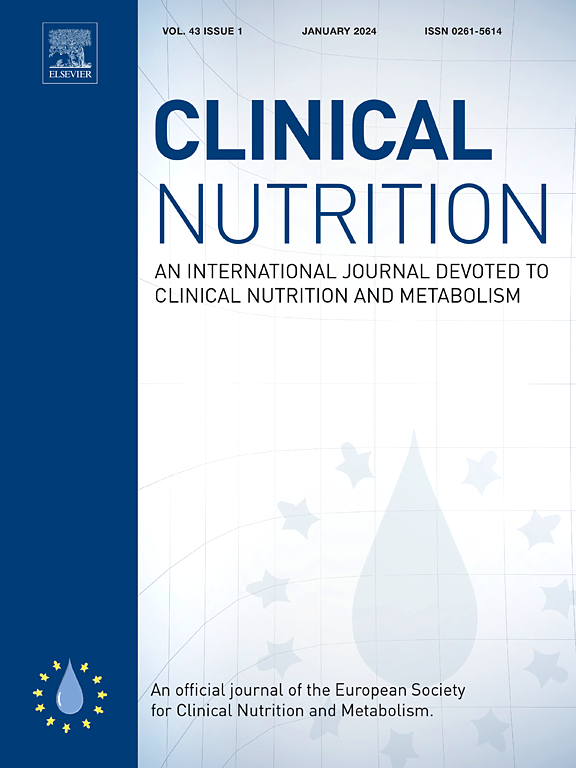AI4Food, a feasibility study for the implementation of automated devices in the nutritional advice and follow up within a weight loss intervention
IF 6.6
2区 医学
Q1 NUTRITION & DIETETICS
引用次数: 0
Abstract
Background & aims
The widespread prevalence of NCDs calls for an improvement in their prevention and treatment. Wearable technologies can be an important asset in the development of precision nutrition strategies, for both health professionals and patients. However, their clinical use is hindered by a lack of validation against current methodologies or appropriate tools to deliver nutritional strategies based on their data. Our study includes manual and automatic data capture methods within a weight loss intervention with the aim to create an essential asset for the implementation, validation, and benchmarking of AI-based tools in nutritional clinical practice.
Methods
This is a feasibility prospective and crossover controlled trial for weight loss in overweight and obese participants, randomized into two groups: Group 1 used manual data collection methods based on validated questionnaires for the first two weeks; while Group 2 started with automatic data collection methods consisting of wearable sensors. After two weeks, the two groups switched data collection methods. Lifestyle data, anthropometric measurements and biological samples were collected from all participants.
Results
A total of 93 participants completed the nutritional intervention designed for weight loss, achieving a mean reduction of 2 kg (V1: 84.99 SD ± 13.69, V3: 82.72 SD ± 13.32, p < 0.001). Significant reductions were observed in body mass index, visceral fat, waist circumference, total cholesterol, and HbA1c levels. The use of electronic devices proved satisfactory among the participants (System Usability Scale score 78.27 ± 12.86). We also report the presence of distinct patient groups based on continuous glucose measurements.
Conclusion
This study has yielded a large amount of data and has showcased how automatic data collection devices can be employed to gather data in the context of a nutritional intervention. This will enable the implementation of AI-based tools in nutritional clinical practice.
Clinical trial registration
ClinicalTrials.gov, NCT05807243.
背景与目标非传染性疾病的广泛流行要求改善其预防和治疗。可穿戴技术可以成为医疗专业人员和患者制定精准营养策略的重要资产。然而,由于缺乏对现有方法的验证,也缺乏根据其数据提供营养策略的适当工具,这些技术的临床应用受到了阻碍。我们的研究包括减肥干预中的手动和自动数据采集方法,目的是为基于人工智能的工具在营养临床实践中的实施、验证和基准设定创造重要的资产。方法这是一项针对超重和肥胖参与者的减肥可行性前瞻性交叉对照试验,随机分为两组:第一组在前两周使用基于验证问卷的手动数据收集方法;第二组则开始使用由可穿戴传感器组成的自动数据收集方法。两周后,两组交换数据收集方法。所有参与者的生活方式数据、人体测量数据和生物样本均被收集。结果 共有 93 名参与者完成了旨在减轻体重的营养干预,平均减重 2 公斤(V1:84.99 SD ± 13.69,V3:82.72 SD ± 13.32,p < 0.001)。体重指数、内脏脂肪、腰围、总胆固醇和 HbA1c 水平均显著降低。参与者对电子设备的使用情况表示满意(系统可用性量表得分 78.27 ± 12.86)。我们还报告了根据连续血糖测量结果划分出的不同患者群体。临床试验注册ClinicalTrials.gov,NCT05807243。
本文章由计算机程序翻译,如有差异,请以英文原文为准。
求助全文
约1分钟内获得全文
求助全文
来源期刊

Clinical nutrition
医学-营养学
CiteScore
14.10
自引率
6.30%
发文量
356
审稿时长
28 days
期刊介绍:
Clinical Nutrition, the official journal of ESPEN, The European Society for Clinical Nutrition and Metabolism, is an international journal providing essential scientific information on nutritional and metabolic care and the relationship between nutrition and disease both in the setting of basic science and clinical practice. Published bi-monthly, each issue combines original articles and reviews providing an invaluable reference for any specialist concerned with these fields.
 求助内容:
求助内容: 应助结果提醒方式:
应助结果提醒方式:


